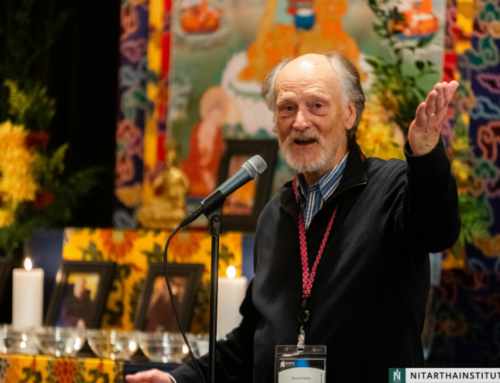This excerpt is copyrighted material, please do not use or copy without written permission from Nitartha Publications.
This is an excerpt from the sourcebook we use in our Mind & Its World II class. Mind & Its World II explores the criteria of valid cognition based on the teachings of the Pramāna tradition, or Buddhist epistemology. We will analyze our consciousness and determine to what degree it is in agreement with its observed object or not; what the difference is between non-mistaken, non-deceiving, conceptual and non-conceptual types of awareness. Practically speaking, this also provides the practitioner with the tools for delineating conceptual and nonconceptual types of mind in meditation.
The Way Consciousness Apprehends Objects
Acharya Sherab Gyaltsen
PRESENTATION OF SUBJECTS
We start off with the statement that mind, awareness, and consciousness are equivalent. Then the text posits their definitions and lists the classifications.
MIND, CONSCIOUSNESS & AWARENESS
First, mind is “that which is clear and aware.” Second, consciousness is “that which is aware of objects.” Third, awareness is “that which experiences objects of comprehension.” This is the same as what was presented in the Vaibhāṣhika section.
SELF-AWARENESS
In the presentation of subjects, all of the definitions are the same, but again, there are some slight differences. The Vaibhāṣhikas do not accept self-aware direct valid cognition, whereas the Sautrāntikas do accept self-aware direct valid cognition. Basically the Sautrāntikas added this one extra thing on. The Vaibhāṣhikas accept three types of direct valid cognition, and the Sautrāntikas accept four types. This is the main difference in terms of the presentation of subjects.
THE WAY CONSCIOUSNESS APPREHENDS OBJECTS
The text says:
2.4.1.3. The explanation of the way that consciousness apprehends objects
When consciousness apprehends objects, it is not without an aspect. Rather, [consciousness]
involves an aspect, because it would follow that the object itself is of the entity of clarity, if [consciousness] were aware of the object itself in the mode of clarity without [involving] an aspect.
Hence, they say that consciousness is aware of objects in the following way: When an individual looks at a pure crystal whose hue is changed by some color [underneath], the crystal [20] and the color are both apprehended by the eyes. At this point, the crystal is something that is directly apprehended, and the color is something that is apprehended through [its] reflection. Thus, the individual apprehends two objects of apprehension. In the same way, direct appearances are aspects of nothing but consciousness. Nevertheless, the bases [due to] which consciousness appears as colors and shapes are outer referents—collections of minutest particles that are different in entity from consciousness. It is not the case—as the Vaibhāṣhikas [say]—that the eye sense faculty which possesses form sees [shapes and forms]. Rather, only consciousness is that which sees and so forth. But what is obstructed by walls and such is not seen, since it is prevented from appearing to consciousness.
Consciousness and Objects
Here there are more differences between the Vaibhāṣhikas and Sautrāntikas. As was explained earlier, the Vaibhāṣhikas say that the consciousness directly apprehends objects in a very immediate way. The Sautrāntikas say, however, that it is impossible for consciousness to apprehend objects in an immediate way. Consciousness is mind, objects are form, and between the two there is no connection.
The Object Aspect
Since this is the case, what the Sautrāntikas do accept is that between consciousness and matter, there are things called aspects that perform the function of making a connection between mind and matter. They assert that if such aspects did not perform the function of forging a connection between consciousness and form, there would be the fault that perceived objects would be endowed with the characteristics of clarity and Awareness.
The Sautrāntikas say that consciousness is like a very pure and clear crystal. Any form that is reflected in the crystal, whatever object appears before this crystal, will have all of its colors reflected in the crystal in a very accurate and pure way. When the aspects of an object are reflected in the crystal, when they appear in the crystal, they are of the same nature of the crystal. However, when someone looks at the image reflected in the crystal, they say, “I saw” or “I perceived this form” of the object that is reflected in it. The Sautrāntikas say that in a conventional way it is fine to say “I saw a form.” However, this person is not really looking at the object but is merely looking at the object’s reflection in the crystal. Just as in this case, they say that consciousness apprehends the image or reflection of objects. Objects have their aspects reflected in consciousness, and this is what is perceived.
Outer Objects Are Hidden
Aside from that, form is of the nature of being composed of particles, and mind is of the nature of being clear and aware. Between them, it is impossible for any real or direct connection to be made. For this reason, they say that all outer objects exist in the manner of being hidden. Why are they hidden? Because they are never directly perceived by consciousness. Only their aspect that is reflected in consciousness is perceived. When we perceive forms or hear sounds, the aspects of the hidden specifically characterized objects are reflected in the consciousness that is like a pure crystal. When you view objects reflected in a crystal, you say things like “I saw form” and “I heard sound,” and so on. But the actual specifically characterized object has not been perceived at all.
If Unhindered, Objects Direct Their Aspects Toward Consciousness
As was said before, the Vaibhāṣhikas say that the eye consciousness and the eye faculty directly apprehend form. The Vaibhāṣhikas say that this is the case because if the eye consciousness did not directly perceive forms, if it was only consciousness that apprehended forms, then it would follow that you would be able to see, for example, the people in the house next door because the wall would not get in the way. Consciousness is formless, and thus would be unobstructed and unhindered by forms. So it would follow that you could see the people on the other side of the wall.
The Sautrāntikas responded by saying, “That fault will not effect our assertion. That fault does not apply to us. The reason it does not apply is because for a consciousness to apprehend an object there has to be an object directing its aspect at the consciousness.” They say in the case of perceiving people on the other side of the wall that the wall serves as a barrier for what is on the other side of the wall to direct its aspect at the consciousness. Therefore, for the hidden phenomenon on the other side of the wall to be perceived, it must direct its aspect towards the consciousness. If there is a wall in between the hidden phenomenon and the consciousness, then the aspect is not going to be able to reach the consciousness. They say that the wall serves as a blocking factor for the aspect of the specifically characterized hidden phenomenon to direct its aspect towards the consciousness. For any consciousness to apprehend a form, its aspect has to be directed in an unhindered way towards the consciousness. In that way, they refute the fault that was ascribed to their assertion by the Vaibhāṣhikas.
You can give a very simple example of a crystal ball and a glass on the other side. If there is something that comes in between them and blocks the crystal ball from the glass, then the image of the glass will not be reflected in the crystal ball. However, if you take out what is in the middle, and there is nothing in between them, then the image of the glass will be reflected by the crystal ball. If it is unhindered, if there is nothing between the glass and the crystal ball, and if we look in the crystal ball, then we will be able to clearly see the image of the glass reflected in it. It is just like this.
Consciousness is Endowed with Aspects
For the previous reasons, the Sautrāntikas assert consciousness to be endowed with aspects. Although consciousness does not directly perceive form, it is endowed with its aspect. In terms of the actual way that the consciousness apprehends aspects, there are three different schools within the Sautrāntika system that have their own views about how this happens. They are the Proponents of Nondual Variety, the Half-Eggists, and the Proponents of an Equal Number of Apprehender and Apprehended Aspects.
Take the example of a multicolored object, such as an object that has many colors of white, blue, red, yellow, and so on. All of these different aspects of white, blue, yellow, and red are directed towards the consciousness individually. However, the consciousness from its own side does not arise with the same number of aspects that are directed at it.
Proponents of Nondual Variety
To explain their system, you can take the example of a blue object. This blue object is endowed with many aspects, such as being blue, being impermanent, being produced, and whatever other aspects it may have. All these aspects are cast toward the consciousness. If you ask, “Does consciousness arise endowed with as many aspects as cast toward to it?” the answer is, “No.” The consciousness only arises endowed with the one aspect of blue. This is why they are called Proponents of Nondual Variety. The “variety” applies to the side of the objects, and “nondual” applies to the side of the consciousness. No matter how many aspects are cast toward the consciousness, it only
arises with the one aspect of blue and not any more. That is where the “nondual” part comes in. You could even say “nonplural” in a more general way.
Take the example of a multicolored object, such as an object that has many colors of white, blue, red, yellow, and so on. All of these different aspects of white, blue, yellow, and red are directed towards the consciousness individually. However, the consciousness from its own side does not arise with the same number of aspects that are directed at it. It arises with just one aspect, and that aspect is merely something multicolored. Even though there are many aspects of different colors directed at it, the consciousness itself is endowed with merely the aspect of multicoloredness.
Half-Eggists
The Half-Eggist system is in accord with what would happen if you took an egg and split it in half. You would have two halves of an egg. Again, we will use the example of something multicolored to illustrate their system. On the side of the object, there are many aspects, such as blue, yellow, white, red, and so on, but they do not all face the consciousness. Rather, only one aspect of multicoloredness faces the consciousness. From the side of consciousness, it arises endowed with merely one multicolored aspect. So there is one aspect on the side of the object being cast, and there is one aspect on the side of the consciousness. Thus, the object side is like one half of an egg, and the subject side is like the other half of the egg. For this reason, they are called Half-Eggists.
Proponents of an Equal Number of Apprehender and Apprehended Aspects
The next group is the Proponents of an Equal Number of Apprehender and Apprehended Aspects, or alternatively, you could call them “Proponents of an Equal Number of Consciousnesses.” They are quite easy to understand. On the side of the object, there are many aspects facing the consciousness, as was the case with the Proponents of Nondual Variety. The difference here is that the consciousness arises endowed with just that many aspects. However many aspects are cast toward the consciousness by the object, the consciousness arises with exactly that many aspects. That is why they are called Proponents of an Equal Number of Apprehender and Apprehended Aspects.
Proponents of an Equal Number of Apprehender and Apprehended Aspects in the Higher Systems
From among these assertions of how consciousness apprehends objects, the most popularly accepted one within the higher Buddhist systems is the Proponents of an Equal Number of Apprehender and Apprehended Aspects.
The way in which the system of the Proponents of an Equal Number of Apprehender and Apprehended Aspects is accepted by higher systems of Buddhism is as follows:
First, there are two different types of Proponents of an Equal Number of Apprehender and Apprehended Aspects: those of the Hīnayāna Sautrāntika school and those of the Mahāyāna Chittamātra school. When the Sautrāntika-Mādhyamikas explain the conventional way in which consciousness apprehends objects, they agree with the presentation of the Sautrāntikas. Among the Sautrāntika presentations, they are in harmony with the presentation of the Proponents of an Equal Number of Apprehender and Apprehended Aspects. When the Yogāchārya-Mādhyamikas explain the conventional way in which consciousness apprehends objects, they are in accord with the Chittamātra presentations. Among the Chittamātra presentations, their presentation accords with the Proponents of an Equal Number of Apprehender and Apprehended Aspects of the Chittamātras. Thus, there are the Sautrāntika Proponents of an Equal Number of Apprehender and Apprehended Aspects and the Chittamātra Proponents of an Equal Number of Apprehender and Apprehended Aspects. Second, there are two types of Mādhyamikas. One system is the Sautrāntika-Madhyamaka system, and the other system is the Yogāchārya-Madhyamaka system. When the Sautrāntika-Mādhyamikas explain conventionally how consciousness works, they are in harmony with the Hīnayāna Sautrāntika Proponents of an Equal Number of Apprehender and Apprehended Aspects, and when the Yogāchārya-Mādhyamikas explain how consciousness works, they are in harmony with the Chittamātra Proponents of an Equal Number of Apprehender and Apprehended Aspects.
One difference is that the Chittamātras do not accept that the director of objects is a hidden phenomenon. The object that directs or casts its aspects toward the consciousness in the Chittamātra system is not hidden. In general, there are a lot of differences, but that is the main one.





